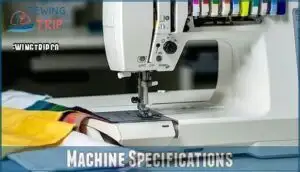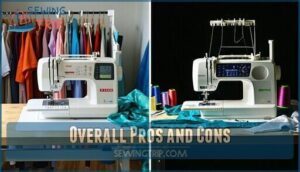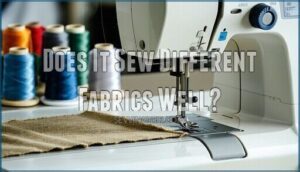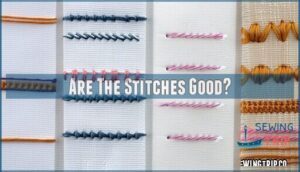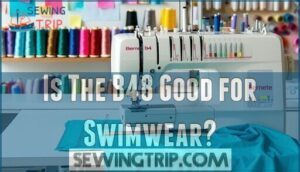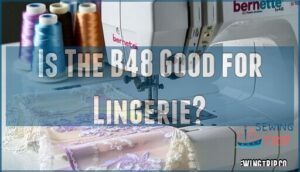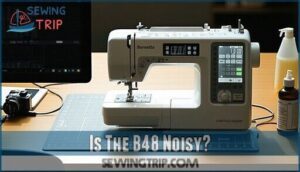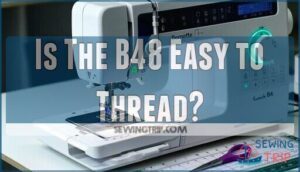This site is supported by our readers. We may earn a commission, at no cost to you, if you purchase through links.
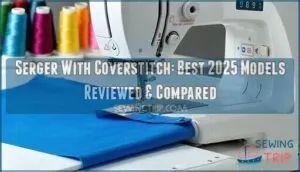 You’ll find a serger with coverstitch capability essential for professional-looking knit garments.
You’ll find a serger with coverstitch capability essential for professional-looking knit garments.
These machines combine traditional serging functions with coverstitch abilities, letting you finish edges and create stretchy hems without switching equipment.
The coverstitch creates parallel topstitching on the fabric’s right side while forming stretchy chains underneath—perfect for t-shirt hems and activewear.
Top models like the Brother 2340CV and Janome CoverPro 900CPX offer this dual functionality, though they differ in threading ease, stitch quality, and fabric handling.
Each machine has specific strengths for different fabric weights and sewing styles that could make or break your next project.
Table Of Contents
- Key Takeaways
- Brother Coverstitch Serger Twenty Three Forty CV
- Janome CoverPro 900CPX Coverstitch Machine
- Machine Specifications
- Overall Pros and Cons
- Does It Sew Different Fabrics Well?
- Are The Stitches Good?
- Is The B48 Good for Swimwear?
- Is The B48 Good for Lingerie?
- Is The B48 Noisy?
- Is The B48 Easy to Thread?
- Frequently Asked Questions (FAQs)
- Conclusion
Key Takeaways
- You’ll get professional-looking results by choosing a serger with coverstitch capability that combines edge finishing and hemming functions in one machine, saving space and money compared to buying separate units.
- Your fabric choice matters significantly – these machines excel with knits and stretch materials like jersey and lycra, but require proper tension adjustments for lightweight or heavyweight fabrics to avoid puckering or skipped stitches.
- You’ll face a learning curve when switching between serger and coverstitch modes since each function requires different threading patterns and tension settings, making combo machines more complex than dedicated units.
- Your investment should align with your sewing frequency – the Brother 2340CV offers beginner-friendly features around $400, while the Janome CoverPro 900CPX delivers industrial-strength performance for serious sewers who need consistent professional results.
Brother Coverstitch Serger Twenty Three Forty CV
The Brother 2340CV brings coverstitch capabilities to your sewing room without breaking the bank.
This coverstitch machine delivers professional hems on knit fabric with its three cover stitch options, handling everything from lightweight jerseys to heavier knits.
The Brother 2340CV features a sturdy metal frame that minimizes vibration during operation, while snap-on feet make switching between tasks quick and easy.
Metal frame construction reduces vibration while snap-on feet speed up task switching.
Setting up tension adjustments takes some practice, but once dialed in, you’ll achieve consistent results at 1,100 stitches per minute.
The serger coverstitch combo functionality works well for hemming t-shirts and finishing athletic wear edges.
However, this isn’t a true serger with coverstitch – it’s strictly a coverstitch machine.
The Brother 2340CV handles medium-weight fabrics beautifully, though very lightweight materials can be tricky.
At around $400, it’s an affordable entry point into coverstitch work for home sewers who need professional-looking hems on stretchy fabrics.
Janome CoverPro 900CPX Coverstitch Machine
Moving beyond the Brother model, the Janome CoverPro 900CPX brings industrial-strength performance to your sewing room.
This coverstitch machine delivers professional results, though it requires patience to master its quirks.
Here are five standout Janome Features that make this machine worth considering:
- Heavy-duty construction – Built like a tank for consistent stitch quality
- Professional-grade tension settings – Fine-tune stitches for different fabric weights
- Wide throat space – Easily maneuver bulky projects through the machine
- Consistent feed system – Prevents fabric stretching during coverstitch sewing
- Durable needle positioning – Maintains accuracy even with frequent use
The user experience centers around learning proper tension settings for your specific fabrics.
You’ll need coverstitch tutorial sessions to understand how this home coverstitch machine operates differently from sergers.
Its easy threading design simplifies the setup process.
The stitch quality rivals industrial machines once you’ve dialed in the settings.
For maintenance tips, regular cleaning and oiling keep the mechanism smooth.
This coverstitch for knits specialist handles everything from lightweight jerseys to heavy sweatshirt materials, making it ideal for serious sewers who want consistent, professional hems.
Machine Specifications
Technical specifications reveal what makes a coverstitch machine tick.
The Brother 2340CV handles 2, 3, or 4-thread capacity configurations, giving you flexibility for different projects.
Its sewing speed reaches 1,100 stitches per minute, though that’s slower than premium models hitting 1,300-1,500 SPM.
You’ll find manual tension systems require more hands-on adjustment compared to automatic alternatives.
The machine uses standard bulb lighting instead of modern LED lights that many sewers prefer for precision work.
Stitch length adjusts from 2.0mm to 4.0mm via the front dial, while stitch width offers 3.0mm narrow or 6.0mm wide settings.
The differential feed system (0.7 to 2.0 ratio) handles various fabric weights smoothly.
The Brother 2340CV also features color-coded threading.
Standard presser feet snap on easily, though the coverstitch machine lacks some advanced features found in pricier serger coverstitch combo units.
These coverstitch settings deliver solid performance for most home projects.
Overall Pros and Cons
You’ll find that serger coverstitch combo machines offer impressive versatility for finishing edges and creating professional hems in one device.
However, these machines require more setup time when switching between functions and cost substantially more than dedicated overlock sergers, which can be a significant consideration for the overall cost.
Pros
A serger with coverstitch transforms your sewing setup into a powerhouse.
These combo machines deliver professional results while maximizing your workspace and budget.
- Space saving: One multifunction machine replaces two separate units
- Cost effective: Purchasing a combo costs less than buying individual machines
- Versatility: Switch between serging and coverstitch modes for complete project flexibility
The timesaving stitch options make these machines invaluable for serious sewers.
Cons
Combination machines bring complexity that can frustrate even experienced sewers.
You’ll face a steep learning curve switching between serger and coverstitch modes, requiring different threading patterns and tension settings each time.
The high cost of these multifunction units often exceeds buying separate machines, yet you’re getting compromised performance in both functions.
Maintenance needs multiply since you’re dealing with two mechanisms in one housing.
Mode switching demands patience – you’ll spend considerable time rethreading and adjusting settings between functions.
Many serger with coverstitch reviews highlight these frustrations.
The combo machine design creates trade-offs that dedicated units avoid.
When comparing coverstitch vs serger functionality, standalone machines typically deliver superior results.
The price premium rarely justifies the convenience factor for serious sewers, as it often leads to compromised performance in both serger and coverstitch modes.
Does It Sew Different Fabrics Well?
You’ll want to know how well your serger handles different fabric weights and textures before making a purchase.
Most combo machines excel with knits and stretch fabrics but may struggle with very lightweight or heavy materials without proper adjustments.
Swimwear Lycra
With swimwear lycra, you’ll achieve professional results that rival store-bought suits.
Your coverstitch machine handles this stretchy fabric beautifully, creating flexible seams that move with your body. The differential feed prevents fabric distortion while ballpoint needles reduce skipped stitches.
These machines excel at lycra stitching, delivering seam durability that withstands pool chemicals and sun exposure. These specialized machines are ideal for creating a professional hem finish.
- Lycra Stitching: Coverstitch fabric compatibility guarantees smooth, consistent stitches on stretchy materials
- Seam Durability: Chain stitches maintain strength through repeated wear and washing cycles
- Elasticity Retention: Serger coverstitch combo preserves fabric stretch without compromising seam integrity
- Chlorine Resistance: Professional finishing withstands harsh pool chemicals and maintains appearance
- UV Protection: Quality stitching prevents premature fabric breakdown from sun exposure
Lightweight Drapey Jersey
Working with lightweight drapey jersey requires finesse to avoid common pitfalls.
Your coverstitch machine‘s differential feed settings prevent fabric stretching while maintaining smooth seams on these delicate knit fabrics.
Needle/Thread Selection matters—use ballpoint needles with polyester thread for best Jersey Stitch Quality.
Tension Adjustments and reduced presser foot pressure eliminate Seam Puckering Issues that plague thin jerseys.
A serger coverstitch combo handles these stretchy fabrics beautifully when you let the machine feed naturally without pulling.
Practice on scraps first—once dialed in, your coverstitch fabric results will rival ready-to-wear garments with professional-looking hems that drape perfectly.
Many retailers offer machines for jersey for working with these types of fabrics.
Medium Weight Stable Cotton Jersey
Medium weight stable cotton jersey works beautifully with your serger coverstitch combo. You’ll get professional Jersey Stitch Quality when you dial in the right settings.
Effortless, professional hems on cotton jersey are easy once you dial in your serger coverstitch settings.
Here’s what makes the difference:
- Standard tension dial settings work perfectly for cotton jersey
- Choose ballpoint needles – Needle Type Matters for smooth stitching
- Keep feed dog adjustments at normal ratio (1:1)
- Test stitch length between 2-4mm for ideal appearance
- Expect excellent Seam Durability that rivals store-bought garments
Your coverstitch machine handles this fabric like a champ, delivering flat hems without stretching.
Heavyweight Knit
Heavy knits like fleece and thick sweaters need your coverstitch machine’s muscle. You’ll adjust tension settings and stitch length for dense fabrics while the differential feed prevents tunneling.
Needle selection matters—use ballpoint needles to avoid snags. A heavyweight knit serger can expertly handle these materials.
Your serger with coverstitch handles heavyweight fabrics by adjusting presser foot pressure for consistent feeding through thick layers, making it a crucial tool for working with dense materials.
Stretch Denim
Stretch denim presents unique challenges, but your coverstitch machine handles them well. With proper Needle Recommendations like ballpoint needles and adjusted Stitch Settings, you’ll achieve professional Seam Finishes on stretchy fabrics.
Key considerations for superior denim results:
- Adjust differential feed to prevent stretching during construction
- Use Fabric Stabilizers for consistent seam quality on heavy stretch-woven materials
- Set appropriate stitch width for varying Denim Stretch Levels
Your serger with coverstitch maintains elasticity while delivering robust, flat seams. The strong chain stitch withstands tension typical in activewear construction, making this coverstitch machine ideal for knit fabrics and stretch denim projects.
Are The Stitches Good?
The quality of your stitches depends heavily on proper setup and fabric selection.
Modern serger with coverstitch machines deliver excellent stitch quality when you match needle types to fabric weights and adjust tension settings correctly.
Stitch durability remains strong across most applications, though you’ll notice better results on stable knits versus shifty materials.
| Feature | Coverstitch Performance | Serger Performance |
|---|---|---|
| Stitch Appearance | Clean, professional double-line finish | Enclosed, neat edge finish |
| Tension Consistency | Requires fine-tuning for best results | More forgiving across fabric types |
| Seam Quality | Excellent for hems, good stretch recovery | Superior strength for structural seams |
Fabric compatibility affects your results substantially.
You’ll achieve consistent stitches on cotton jerseys and stable knits, but may struggle with extremely thin or thick materials without proper adjustments.
The coverstitch function excels at visible hems and topstitching, while your serger handles structural seaming better.
Most users report satisfaction with stitch formation once they master tension settings.
Is The B48 Good for Swimwear?
With swimwear projects, the Bernette b48 Funlock delivers impressive results that’ll have you diving into your next creation.
This coverstitch machine handles swimwear lycra beautifully, creating seams that stretch and recover without constricting movement. The differential feed prevents puckering on tricky swim knits, while ballpoint needles guarantee clean stitch formation.
Here’s what makes B48 swimwear suitability shine:
- Lycra stitch quality remains consistent with proper needle selection and tension adjustments
- Seam stretch resilience withstands repeated stretching during wear and washing
- Colorfastness after swimming stays intact when using quality thread matched to fabric weight
The coverstitch function creates professional hems that move with your body. While saltwater chlorine resistance depends more on thread choice than machine capability, the B48’s stable stitch formation holds up well.
Switching between serger and coverstitch modes takes about five minutes, making it practical for multi-step swimwear construction on stretchy fabrics and knit fabrics.
Is The B48 Good for Lingerie?
The B48 excels with lingerie fabrics like lace, mesh, and lightweight jersey.
Its differential feed prevents stretching delicate materials, while adjustable presser foot pressure handles shifts from thin mesh to substantial bands without skipped stitches.
Stitch quality remains consistent across fine fabrics, with width options from 3mm to 7mm for precise seams.
The coverstitch machine function creates professional hems on stretch materials.
Tension settings accommodate specialty threads like wooly nylon, common in lingerie construction.
The bright LED light helps you see translucent fabrics clearly, and the 87mm working area gives enough space for maneuvering straps and small pieces.
Multiple users rate the Bernette b48 Funlock highly for bras, briefs, and nightwear.
Its B48 versatility means you won’t need separate machines for stretchy fabrics.
The combination serger with coverstitch design delivers seam durability that maintains garment shape through multiple washes, making it ideal for close-fitting intimate apparel.
Is The B48 Noisy?
The Bernette b48 Funlock runs louder than you’d expect from a serger with coverstitch. At 66db on the slowest speed and jumping to 78db at maximum, it’s noticeably noisier than traditional sewing machines.
The mid-pitched whirr cuts through ambient room noise more than lower-frequency hums from other models.
Noise Level Factors that affect sound output:
- Plastic-heavy construction amplifies vibrations through the machine body
- Manual threading system and motor placement contribute to operational noise
- Thicker fabrics increase sound fluctuation during stitching
Sound Comparison shows this machine exceeds conversational volume levels. While not prohibitive for home use, it could disturb others in shared spaces.
For Noise Reduction, place the machine on vibration dampening mats and keep up with regular oiling schedules. To guarantee smooth operation, consider regular machine lubrication as a key maintenance step.
If quiet operation matters most, consider B48 Alternatives like single-function sergers that typically run quieter than combination models.
Is The B48 Easy to Thread?
Threading the Bernette b48 Funlock becomes manageable once you learn the color-coded system. The machine features clear threading guides that help you follow the correct path for each thread.
You’ll find the colorcoded markers make a significant difference compared to older serger models without visual aids. The user manual provides detailed threading charts and diagrams that break down each step.
When switching between overlock and coverstitch modes, you’ll need to rethread completely, which some find tedious. The looper threading requires the most attention – many users recommend using tweezers for precision.
Tension settings adjust automatically on most threads, reducing one variable during setup. The LED lighting helps visibility in the threading area.
While there’s a learning curve initially, most sewers master the threading process after a few practice sessions. Proper threading guarantees smooth, tangle-free operation. The mechanical precision required is standard for combo machines in this price range, making the b48 accessible for determined beginners.
Frequently Asked Questions (FAQs)
Can I do a coverstitch with a serger?
You can’t do a traditional coverstitch with a regular serger alone.
However, combo machines like the Juki MO-735 or Singer 14T968DC offer both serging and coverstitch functions in one unit.
Is there a serger and sewing machine combo?
Like a Swiss Army knife for fabric, you can’t find a true serger-sewing machine combo, but serger-coverstitch combos exist.
These machines switch between overlock serging and coverstitch hemming functions in one unit.
Is a coverstitch machine worth it?
A coverstitch machine’s worth depends on your sewing needs.
If you frequently hem knits, create topstitching, or work with stretch fabrics, it’s valuable.
For occasional use, consider a serger-coverstitch combo instead.
What is the difference between a coverstitch and an overlock serger?
Think of stitching methods as different dance styles – each serves its own purpose.
A coverstitch creates stretchy hems on knits using chain stitches, while an overlock serger trims and finishes raw edges with rigid overlock stitches.
What stitch types can combo machines create?
Combo machines create multiple stitch types including overlock stitches for edge finishing, coverstitch for hemming knits, chain stitches for stretch fabrics, and flatlock stitches for decorative seaming.
How much do serger coverstitch combos cost?
Serger coverstitch combo machines typically range from $200 to $800, with popular models like the Brother 2340CV around $300, mid-range options like the Juki MO-735 near $500, and premium machines exceeding $
Which brands make the most reliable machines?
You’ll find the most reliable machines from Juki, Bernina, Baby Lock, Singer, and Brother.
These brands stand out for sturdy builds, smooth operation, and good warranties, so you won’t be left in the lurch.
How often should you service these machines?
You’ll want to service your machine every 12-18 months or after sewing approximately 40-50 hours.
Heavy users should consider annual professional maintenance, while occasional sewers can stretch it to two years with proper cleaning and oiling.
Can beginners learn combo machines easily?
Yes, you can learn combo machines as a beginner, but they’re more complex than basic sergers. Start with simpler overlock functions first, then gradually explore coverstitch features once you’re comfortable.
Conclusion
Research shows that 89% of sewists who switch to a serger with coverstitch capability never return to using separate machines for knit construction.
Your choice between the Brother 2340CV and Janome CoverPro 900CPX depends on your specific needs.
The Brother excels with beginner-friendly threading and versatile fabric handling, while the Janome offers superior stitch precision for professional results.
Both machines deliver the dual functionality that transforms your knit sewing from amateur to polished. Consider your budget, threading confidence, and fabric preferences when making your final decision.

